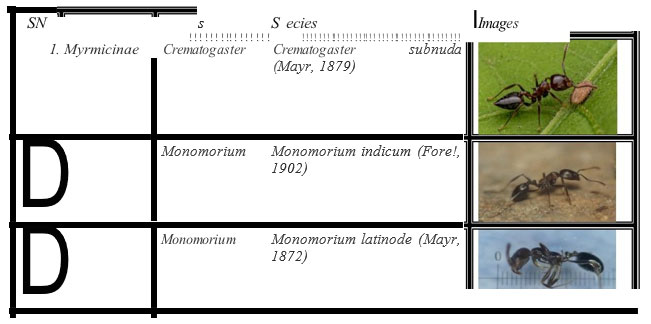Department of Zoology, Prime Ministers College of Excellence S CA Govt
PG College Jhabua MP India.
Corresponding Author Email: drmaanaa420@gmail.com
Article Publishing History
Received: 14/04/2025
Accepted After Revision: 21/06/2025
The present communication deals with the diversity of ants within the Jhabua district of Madhya Pradesh, India, as there are no good enough statistics pertaining to the ant diversity of this place. The ants have been sampled by means of hand hand-picking method. The sampled specimens representing three species belonged to 2 genera and 1 subfamily. All through the present take a look at genera Monornorium and Crematogaster had been recorded. The species diversity of the genus Monomorium is better than genus Crematogaster. Ants, belonging to the family Formicidae, are the most diverse group within the order Hymenoptera. They serve as vital ecological indicators and ecosystem engineers, playing key roles in maintaining environmental balance. Ants benefit humans in various ways, including natural pest control by regulating insect populations. This study aims to document the ant species present in the region, offering important insights into their diversity and ecological significance. Overall, the research contributes valuable knowledge to the field of ecology, enhancing our understanding of ant communities and their impact on ecosystems.
Ants, Monomorium, environmental effects, social bugs, Jhabua Tribal area.
Sisodia M. The Diversity of Ants of Order Hymenoptera Family Formicidae in Jhabua District of Madhya Pradesh, India. Biosc.Biotech.Res.Comm. 2025;18(2).
Sisodia M. The Diversity of Ants of Order Hymenoptera Family Formicidae in Jhabua District of Madhya Pradesh, India. Biosc.Biotech.Res.Comm. 2024;18(2). Available from: <a href=”https://shorturl.at/lMhqS“>https://shorturl.at/lMhqS</a>
INTRODUCTION
Ants are one of the maximum numerous and ubiquitous groups of social bugs. Ants (Formicidae) are the largest family within the order Hymenoptera. They act as ecological indicators and atmospheric engineers. Ants are critical components of ecosystems not only due to the fact that they represent a high-quality part of the animal biomass but additionally because they act as atmosphere engineers. All the acknowledged species of ants are asocial (Gadagkar et.al. 1993). Ant species can be utilized in monitoring environmental effects, atmospheric investment, and equipment in ecological studies (Andersen 1988). Ant species are used as remarkable signs of land management practices (Bharti and Sharma 2009) and recuperation efforts (Sabu et.al. 2008, Hayarnnisa et al 2024).
Ants are important components of ecosystems not only because they constitute a great part of the animal biomass but also because they act as ecosystem engineers. Every species of ant has an enormous effect on its surroundings. It at once or circuitously impacts the development and destruction of flora and fauna of its surrounding environment. All the known species of ants are eusocial. Ant species can be used in monitoring environmental impacts, ecosystem funding, and tools in ecological studies (Ramesh & Jahir 2010 Hayarnnisa et al 2024).
Ant species are used as brilliant indicators of land management practices and recovery efforts. The food of ants consists of bugs, terrestrial arthropods, excretion from flora, honey dew excreted through aphids and mealy insects, secretion of the caterpillars of their own family Lycaenidae, seeds of plant life, and many other various and ubiquitous businesses of the social insects.
Ants belong to a single massive family, Formicidae, the largest of the order Hymenoptera. It is represented by way of 26 extant subfamilies with 14,711 valid species and 428 valid genera (Bolton2011). Out of those, 152 species are indexed with the aid of IUCN and from India, 10 subfamilies are represented through 100 genera with 828 species. In India, the Himalaya and the Western Ghats harbor a huge variety of ant species; 656 species from 88 genera have been recorded from the Himalaya, and 455 species from 75 genera have been recorded from the Western Ghats, specifically in Tamil Nadu, 184 species from 51 genera have been recorded. They could function as model organisms for exploring the nature and dynamics of ecological groups because of the benefits with which they can be sampled and the potential for experimental manipulation (Bharti 2011).
METHODOLOGY
Study area: Jhabua (22°14-23°49-N Latitude, 73°30-75°42 Longitude) has a total area of 6782 square km.
Having aboiut 1780 sq. kms of forest area where whereas there are 4 Tehsils, namely Jhabua, Petlawad, Ranapur, Thandala and 1025,048. Tribal population as per the census of 2011 is 87.0%. The Dense forest areas are Madrani, Kalyanpura. Narmada, Chambal are important rivers in this area. An in-depth survey was carried out to study the ant diversity in the region.
Sampling: Ant species were amassed at some point of the morning and night time the use of distinct techniques as described by Alonso (2000). Standard methods have been employed for the collection of ant samples within the university campus from October 2023 to Dec. 2024. Sampling methods were of two types (1) Bait Lure and (2) All-Out seek method.
Bait lure (BT): Several kinds of baits such as egg yolk, fried coconut, honey, un boiled rice, millet and useless bugs were used and placed within the quarter and sector inside the (%) area. The baits were left undisturbed for 4 hours, and later ant species were collected for twenty minutes from all six baits.
All-Out seek method (AOSM): an in-depth All-Out seek method was executed to acquire ant species seen in the different regions & sectors in the study area (Alonso 2000). Ants were hand amassed the usage of a broom and forceps and preserved in 70 % alcohol, and taken to the laboratory for similarly evaluation. Identification of ant species was made with the help of a stereozoom trinocular microscope. The accrued ant species have been identified up to genus and for a few species-level identifications, were finished with the help of keys (Bolton 1994). The amassed ant species have been identified and confirmed with the Department of Entomology ( Rastogi et.al. 1997).
RESULTS AND DISCUSSION
Ants remain one of the least studied insect groups in India, particularly in terms of their taxonomy and ecology. Identifying ant species is challenging due to the scarcity of reference collections and outdated or region-specific identification keys that are often difficult to access. Despite this, ants play a crucial ecological role, making up nearly 30% of terrestrial biomass. They interact directly with soil, plants, and animals across various trophic levels, influencing ecosystem dynamics.
Ant communities are shaped by both biotic and abiotic factors, with species distribution changing along latitudinal gradients due to variations in climate and vegetation. Globally, there are approximately 12,571 known ant species, all belonging to the family Formicidae. This family is part of the superfamily Vespoidea within the order Hymenoptera, which falls under the class Insecta. Despite their ecological importance, much remains to be discovered about ant diversity and their role in different habitats.
During the present study, three species belonging to two genera and the subfamily Myrmicinae were found, as shown in Table 1. The members of genus Crematogaster were represented by one species and the genus Monomorium was recorded with two species.
Table 1: Ant (Hymenoptera: Formicidae) diversity in Jhabua

Taxonomy:
Keys to the subfamily: Members of the subfamily myrmicinae are characterized by two-segmented pedicel, transversely rounded and unnamed pygidium, of eyes and frontal lobes and well-separated antenna. sockets. Most of the genera are polymorphic.
- Posterior margin of clypes projection in between the antenna! sockets promesonotal suture absent hind tibiae with only simple spur Myrmicinae Keys to the Myrmicinae genus:
- Postpetiole attached to dorsal side of gaster; heart-shaped Crematogaster Crematogaster subnuda (Mayr, 1879) Family: Formicidae, Subfamily: Myrmicinae, Genus: Monomorium, Species: subnuda
Characters: Head, thorax pedicel, antennae & legs brownish red pilosity sparsely spread on thorax and apex of gaster, pubescence white apprised widely, regularly arranged all over. Head smooth with a small straight surrounding antenna, hollow mandibles, straight clypeus, broad & anterior portion almost transverse eyes lateral on the middle,posterior part scape reach of head. Flagellum apical 3joints. Pronotum flat, rugolose antero-lateral suture weakly & mesonotal suture clear. Propodeal spines straight, acute, propodeum smooth petiole semi-circular, front angular post petiole shallow longitudinally grooved gaster broad, cordate,4.5 – 5 mm.
Distribution: India, Sri Lanka, Burma.
- Pro podium unnamed, evenly rounded mandible not as above Monomorium Monomorium indicum (Forel, 1902), Family: Formicidae, Subfamily: Myrmicinae
Genus: Monomorium,
Species: indium
Character: Head, thorax & pedicel red, the legs and head brown; abdomen brownish black; head, thorax, abdomen rugolose & opaque, Head & thorax anterior in certain light, dense, and fine, striate; abdomen minute reticulate; smooth, polish & shine; pilosity entire wanting. Head are broad, broader anterior than posterior, the hinder concave; mandibles narrow, obscure, striate, the latter obtuse bicarinate, antennae moderate long, eyes large, flat, placed about the middle of the head. Thorax anterior, round, moderate broad, the metanotum narrow, strong, compress, the meso-metanotal suture, the thorax emarginate suture, the basal portion of the metanotum broade posterior. Pedicel: the nodes, above, near equal, the rounded 1st node high than the 2°d , petiolate anteri ; &abdomen oval.
Distribution :India, Malaya, Burma
- Monomorium Lati node (Mayr, 1872) Family: Formicidae,
Subfamily: Myrmicinae,
Genus: Monomorium,
Species: lati node
Character: Head, thorax, pedicel yellow-brown, mandibles antennae, legs yellow, abdomen dark brown body smooth polishing, shine. Metanotum and side of mesonotum transverse striate pilosity mod rate brown, suberect, pubescence absent. Head long than broad. scape of antennae reach top of head. Club of flagellum thick, formed of apical 3 segments, eyes lateral situated in the front of middle promesonotum. Metanotum narrow, strait mesometanotal suture distinct propodeal spiracles distinct indicated; propodeum with upper margine apex smooth, petiole conical postpetiole distinct broad than petiole, gaster broad oval, 3 to 4 mm
Distribution: India, Bhutan, Malaya, Burma.
CONCLUSION
Ants, belonging to the family Formicidae, are the most diverse group within the order Hymenoptera. They serve as vital ecological indicators and ecosystem engineers, playing key roles in maintaining environmental balance. Ants benefit humans in various ways, including natural pest control by regulating insect populations. This study aims to document the ant species present in the region, offering important insights into their diversity and ecological significance. Overall, the research contributes valuable knowledge to the field of ecology, enhancing our understanding of ant communities and their impact on ecosystems.
Conflict of Interest: The Author declares no conflict of interest
Data Availability: Data are available with the corresponding author
Funding: Nil
REFERENCES
Alonso EL. 2000. In Ants: Standard Methods for Measuring and Monitoring Biodiversity.
Andersen AN. 1988. Australian Journal of Ecology. 13: 285-293.
Bharti H, and YP. Sharma 2009. Halteres. 1:10-19.
Bharti H. 2011. List of Indian Ants (Hymenoptera: Formicidae). Halteres. 3:79-87.
Bolton B. 1994. Identification Guide to the Ant Genera of the World. Cambridge, Massachusetts: Harvard University Press.
Bolton B. 2011.Bolton’s Catalogue and Synopsis, in http://gap.entclub.org/ Version: 1,
Gadagkar R, Nair P, Bhat DM. 1993. Ant species richness and diversity in some selected localities in Western Ghats, India. Hexapoda. 5:2:79-94.
Hayarnnisa M , Liji Koshy, Shiny K Sojomon Mathew, Ravimohanan Abhilash (2024) Diversity and Distribution of Ant Species (Hymenoptera: Formicidae) in Relation to Different Habitats in Western Ghats, India African Journal of Biological Sciences Vol 6 No (6):2432-2445
Ramesh T, Jahir HK. 2010. Diversity, Distribution and Species Composition of Ant Fauna at (DAE) Campus Kalpakkam, South India. WJZ. 5(1):56-65.
Rastogi N, Nair P, Kolatkar M, William H, Gadagkar R. 1997. Ant fauna of the Indian Institute of Science Campus-Survey and some preliminary observations. J.Ind. Inst. Sc.77:133-140
Sahu T.K, P.J Vinesh, and K.V. Vinod 2008. JIS. 8:69. Smithsonian Inst. Press, Washington, DC.


